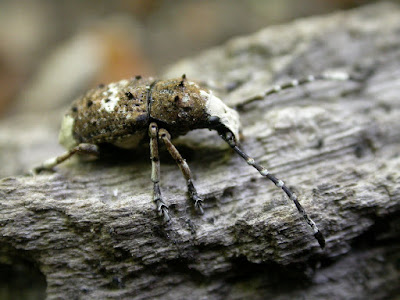Chonky, cryptic, rare, tufted and saproxylic; can you ask any more of a beetle!?
Posted by Graeme Lyons , Saturday, 30 May 2020 20:38
On Friday I beat this amazing little anthribid from a dead oak limb in East Sussex. This is Pseudeuparius sepicola, something I have wanted to see for some time since Peter Hodge mentioned there was an old record from the Mens. This was on a farm in East Sussex, where it is the first record for the county, and the first in Sussex since the 1960s. It's listed as RDB2, Vulnerable. Mark Gurney said it rarely turns up in the same place twice, so it must be really hard to find. I feel really lucky as, although it was a great site for wildlife, it wasn't a particularly good site for saproxylic beetles; this species was NOT on my radar. Here are some more shots of what is a frustratingly mobile beetle to photograph.
The tree was an open-grown oak between two fields at the end of a thin strip of scrubby-woodland. Here is the tree.
And the branches I tapped it from. So really nothing hugely different to almost every decent sized oak tree! Probably my find of the year so far. I was at the time walking along the other side of the fence and had a lot of ground to cover but at the last minute I decided to make a short diversion to beat the oak foliage of this tree. As I was leaving the tree, I noticed the small dead limbs underneath and had a bash. It's amazing how so much of entomology is chance! The previous day, yet another Cantharis rustica tanked overhead and I figured I should check it just in case, I turned and dashed after it. It was only Stenostola dubia! I always think it's worth going that extra mile. If something pops into your head or makes you think about it, ALWAYS go for it. I think there is a great deal of room for creative thinking in entomology, more often than not, this is where the unusual findings are. So it's not just chance. I suppose you make your own luck.
I might as well go through the other anthribids I have seen, as there are only four in all. They are all such smart beasts. Chonky, cryptic, scarce, mostly saproxylic and highly photogenic. What's not to like? Anthribus fasciatus, I have only seen this once, at Knepp in 2015. This is the only one of these four that's not saproxylic.
Platystomos albinus, an annual encounter in Sussex. I have 11 records for this, seen it once already this year.
And Platyrhinus resinosus, still surprisingly rare in Sussex, I have nine records but only one of these is from Sussex. As soon as you go into Surrey or Kent it becomes much commoner.


















Hello Graeme!
I found this a very interesting post. Taking photos of such little insects can be tying but very rewarding, isn't it? Greetings from Sri Lanka!